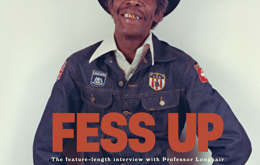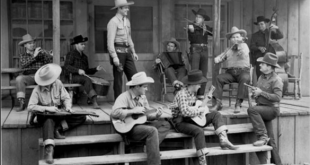Geography, it’s been said, is destiny. Woody Guthrie is defined by two widely contrasting geographies, the Texas Panhandle of the Dust Bowl `30s and the New York City of the folk Left `40s. But two recent books convincingly argue that it was actually the West Coast that made Woody Guthrie, well, Woody Guthrie.
The first offers twelve essays by as many authors under the title Woody Guthrie L.A. 1937 to 1941, edited by Darryl Holter and William Deverell (Angel City Press, Santa Monica, 2015). Historian Peter La Chapelle lays out the book’s thesis in a chapter on Woody’s earliest known recordings (The Guthrie Prestos: What Woody’s Recordings Tell Us About Art and Politics): “Los Angeles, not New York, served as locus of Woody’s political transformation…it was in Southern California that he really began to blend the folk and commercial music-making traditions of his home region with the kind of politics he would eventually be associated with.”
Guthrie hopped freights to California in the Spring of 1937, putting him squarely in the midst of an historic exodus from economic and ecologic disaster: Between 1935-1940, nearly 100,000 `Dust Bowlers’ arrived in Los Angeles. Most sought agricultural work, but Guthrie had been playing and singing for tips since his teens and would do the same on L.A.’s Skid Row. After only a couple of months in L.A. Woody and his cousin Jack Guthrie landed a daily 15-minute radio show on KFVD, The Oklahoma and Woody Show. When Jack departed, Woody enlisted twenty-two-year-old Maxine Crissman as new duet partner, christening her Lefty Lou (Crissman was left handed and Lou rhymed with `Old Mizzou’: her family was from Missouri). Woody and Lefty Lou sang the sort of `heart songs’ familiar to migrants from the southeast; they soon became the most popular act on KFVD.
At that stage Woody performed a few self-penned songs but initially they were apolitical. That changed after KFVD owner and political progressive J. Frank Burke Sr. enlisted Woody to tour labor camps and other more haphazard `Dust Bowler’ enclaves and report his observations. Along with the popular Woody and Lefty Lou radio show, Burke gave Guthrie a column in his newspaper The Light. Years later, `Lefty Lou’ Crissman recalled: “The political stuff began after he went into the camps. I never heard that before he went up to the labor camps.”
Guthrie increasingly identified with the migrants and had a business card made which announced “Woody, th’ Dustiest of th’ Dust Bowl Refugees.” Public awareness of their plight peaked in 1939 with the publication of John Steinbeck’s The Grapes of Wrath, the same year the Hollywood Tribune’s James Forester wrote: “I think Woody is a new voice straight from the heart, a kind of Will Rogers, only still closer to the pain of his own folks than Rogers was.” Guthrie knew that pain first hand. He wrote most of his Dust Bowl Ballads in California, and, following the example of his idol, Will Rogers, became columnist for sundry papers while in L.A.: The Light, the Hollywood Tribune, and the People’s World. Ironically the man who set Woody on his leftward journey, J. Frank Burke Sr., fired him from KFVD when he became too much what fellow KFVD singer Stuart Hamblen disparaged as `the Communist cowboy.’ With little more than Skid Row tips to fall back on, Guthrie left L.A. (though he would return) and by the end of 1939 was in New York City.
Guthrie’s transformative time in L.A. is thoroughly explored in Woody Guthrie L.A. 1937 to 1941. The intersection of Guthrie’s faith and politics is detailed: “Jesus don’t care if you call it socialism or communism,” he wrote, “or just me and you.” But Guthrie’s politics weren’t entirely `Party line,’ as Ronald Briley writes in his chapter (Woody Sez—The People’s Daily World and Indigenous Radicalism): “Woody’s politics are often ambiguous, paradoxical, and confusing.” So, too, was Woody the man: “Woody loved a fast car,” recalled his friend Will Geer, “and he would drive it like hell on wheels, and he loved women…Like most poets, Woody was deeply, passionately sexual in his life and in his work.”
Woody’s poetry is something he just naturally exhaled: Describing unemployed men stranded by a Barstow roadside, he wrote: “These people are mostly the ones who have tired of marching with the starvation armies of wandering workers and grown weary of the smell of rotting fruit crops.” In columns, songs and books he knocked off reams like that, and better. He was steeped in Walt Whitman: His 1939 dedication of his “Fifth Street Blues” is thoroughly Whitmanesque: “In respect and honor to 5th St., Los Angeles, California, for the Spirit that abides there, and for the people who go there, by the forces of an unbalanced social order, or by their own free will…I love the Spirit and the people that walk there.”
Woody also seems a bridge in deed, spirit, and stream-of-consciousness word to Jack Kerouac, but that’s a connection not explored in Woody Guthrie L.A. 1937 to 1941. Woody-as-proto-Beat may be beyond the book’s scope, but the influence on Guthrie of another Oklahoman who made good in Hollywood, Will Rogers, isn’t. Guthrie famously regarded him as second only to Jesus Christ, and it would have been good to read more about the impact Rogers’ wry down home political commentary had on Guthrie. The Will-Woody connection deserves a thorough work up one day.
Given the riches offered in this book, it seems churlish to chide what’s missing, but the devil’s in the details: Historian Darryl Holter, author of three of the book’s chapters, authoritatively pins Woody arriving in L.A. in May 1937, yet Ronald Briley’s chapter dates it as 1936. A tiny edit could’ve fixed that discrepancy. Likewise a generally excellent chapter by Dan Cady and Douglas Flamming on the evolution of Guthrie’s racial consciousness (Ramblin’ in Black and White) states: “Lead Belly sang the Delta Blues on national radio and in concert.” Huddie Ledbetter was a `songster’ for whom blues was only part of his repertoire, and his original stomping grounds were Texas and Louisiana, not the Mississippi Delta. A minor point in context, that’s still a detail that questions a writer’s knowledge of the music.
But there’s plenty to praise in Woody Guthrie L.A. 1937 to 1941, starting with Amy Inouye’s design: its bright red spine and gray cover cleverly echoes the look of old Library of Congress 78 albums. The inclusion of (and Tiffany Colannino’s chapter on) Woody’s editorial cartoons is a visual treat, as are rarely seen photos, including one of Guthrie singing at a labor camp. The book both documents Guthrie’s time in L.A. and the more recent influence, musical and cultural, of his songs “Tom Joad” and “Deportee.” Anyone interested in what Guthrie recorded, and where and when, will be grateful for Darryl Holter’s closing chapter, “Woody Guthrie’s Recordings, 1939 to 1949.”
If L.A. was the forge that steeled Woody Guthrie, the Pacific Northwest was host to his finest hour (or month). That’s the thesis of 26 Songs in 30 Days: Woody Guthrie’s Columbia River Songs and the Planned Promised Land in the Pacific Northwest by Greg Vandy and Daniel Person (Sasquatch Books, Seattle, 2016). In May of 1941 28-year-old Woody Guthrie was hired by the Bonneville Power Administration to write songs for a film extoling the benefits of hydroelectric power generated by the Columbia River. Under the watchful eye of the BPA’s information officer Stephen Kahn, Guthrie took in the scenery for inspiration and spewed forth a host of songs, some of which survive only as lyrics while others (“Roll On Columbia,” “Pastures of Plenty”) became among his best known. That much is common knowledge, but Vandy and Person take on the task of telling the larger, less familiar story of a New Deal era dream of planned communities for displaced `Dust Bowl refugees’ in a freshly irrigated Pacific Northwest, a utopian scheme short circuited by World War II and the use of hydroelectric power instead to produce battleships and bombers. Those promised “Pastures of Plenty” for Woody’s Dust Bowl refugees may explain why the `Communist cowboy’ of 1939 L.A. apparently became a patriotic New Dealer in 1941 Portland.
While 26 Songs in 30 Days focuses on a chapter in regional Pacific Northwest history, Vandy and Person also offer the broad outlines of Guthrie’s complex journey from Okemah, Oklahoma to New York’s Greystone Park Psychiatric Hospital. That they do so in concise and engaging prose is laudable. They manage to make what could be a dull topic (the Bonneville Power Administration) interesting, and a tangled one (the Communist Popular Front in which Guthrie was casual but enthusiastic participant) comprehensible. They’re aided by many evocative period visuals, from vintage BPA posters to Guthrie’s typewritten song lyrics to his May 12, 1941 employment application (job title: `information consultant’). There’s even a period photo of B Street, Grand Coulee, where the workers building the great dam frequented bars and brothels.
It’s understandable that Guthrie is framed by black dust clouds on one side and New York City’s integrated activist folk scene on the other. He built his public persona on an association with the Dust Bowl, and his legacy was carried on into the 1950s-`60s folk revival by NYC disciples Pete Seeger and Jack Elliot. Many Guthrie bios tend to relegate his non-New York activities to background, but these new books argue that Woody may have been at his most creative on the West Coast, where he first tasted success and found issues on which to focus his talent. It was also here that the spectacular beauty of the Pacific Northwest and the massive Grand Coulee Dam project inspired some of his finest, most focused songwriting. Of the two books 26 Songs in 30 Days is the breezier read, but Woody Guthrie L.A. 1937 to 1941 offers welcome depth and detail to our understanding of an artist discovering his message and identity.
 Baja Review A community newspaper serving Ensenada, Valle de Guadalupe, and Rosarito in Northern Baja California
Baja Review A community newspaper serving Ensenada, Valle de Guadalupe, and Rosarito in Northern Baja California





